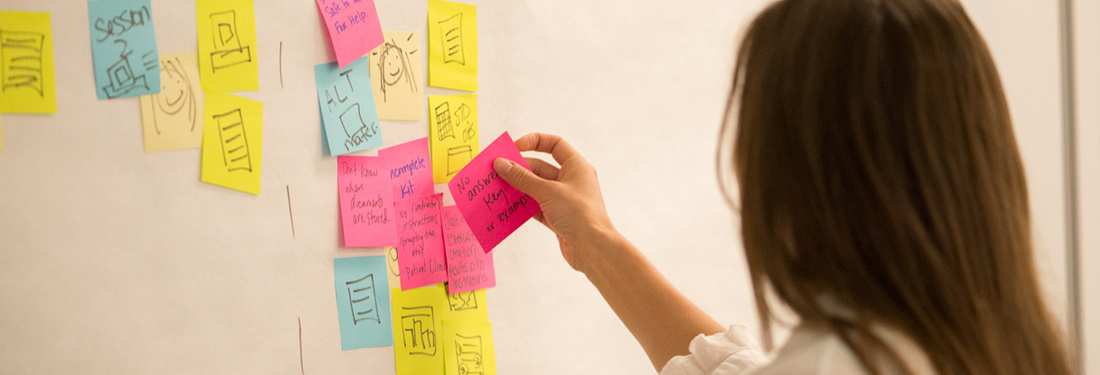Using Lean Ideas in Our Everyday Work
“The most common types of Everyday Lean Ideas involve shaving time off a process. And when you think about the cost in health care one of our most valuable resources is time.”
– Jennifer Phillips
What if employees on the front lines of your organization not only did great work on their assigned job, but simultaneously generated simple ideas to increase efficiency and reduce waste?
That’s the idea behind a program at Virginia Mason called Everyday Lean Ideas (ELIs). The program encourages all employees to identify opportunities to make small scale improvements that are within their control. In other words, improvements where the worker identifies a problem, does the testing and provides the solution — without the need of other resources.
These improvements are the embodiment of the continuous incremental improvement that defines kaizen, the essential element of the Toyota Production System (Virginia Mason has adapted TPS to health care in the form of the Virginia Mason Production SystemTM). At any given moment at Virginia Mason, there are hundreds of small improvement ideas in the pipeline. Not all of those ideas are successful, of course, but even ideas that don’t pan out often provide a useful learning experience to staff.
Jennifer Phillips, innovation director in Virginia Mason’s KaizenPromotion Office, says the ELI system “works best when departments incorporate it into their regular processes, such as staff meetings or huddles. So we know that it is really working well when identifying kaizen opportunities is part of the natural department process.”
When a staff member identifies a problem — say for example, excessive and wasteful paperwork — Phillips and her team stress that the person working on the problem “pick one simple metric. We stress that they work on ideas that are as simple as possible and not get caught up in complicated metrics. A simple metric that answers basic questions: How do you know your idea worked? How do you know it solved the problem?”
Let’s look at an example. A staff member in the Patient Financial Services department — Raquel C. Pagaduan — believed there was too much paperwork related to clinical referrals. “We seldom need to go back to this paperwork,” Pagaduan wrote in her report. “It takes up space and it takes time to copy and file this paperwork.” She reported further:
Key metric to improve:
Reduce inventory, see how often we actually need to go back to the paperwork, reduce time going through old paperwork.
She proposed scanning the referrals then shredding the documents. “In the current state work comes in batched and queued. It goes from one box to another, then to another, and then to another … Work should be processed as soon as it is received … By holding the work and not faxing it to the respective department it delays patient care. It should be one-piece flow.”
Specific results:
We no longer keep any paper records. We fax the information to the clinic sections, wait for the fax success confirmation and then shred the chart notes. This saves approximately 30 minutes a day for the initial preparation that was being done to save the documents and then another two hours per week going through to “clean out” old files.
The results of this simple fix reduced six types of waste: inventory, motion, overproduction, processing, time and transportation. The source of this idea, as is the case with the great majority of improvement ideas in the ELI program, was “personal experiences/observation.”
Phillips says the most common types of ELIs involve shaving time off a process. “And when you think about the cost in health care,” she says, “one of our most valuable resources is time.”
The ELI program is significantly dependent upon where the organization is in the evolution of what Phillips terms “our overall kaizen culture. And we’re pretty far along when comes to philosophy and identifying waste and having ideas but we are still building the more technical skills of kaizen — how do I test my idea? How do I measure? We’re still building PDSA (Plan-Do-Study-Act) skills in the organization.”
Jennifer seeks to measure cultural alignment with Everyday Lean Ideas by posing several questions on the Virginia Mason staff engagement survey:
- My manager gives me time to work on promising new ideas
- My manager makes it clear new ideas are desirable
- My manager recognizes my ideas
When managers recognize the staff members who generate ELIs, there is “huge leverage in staff satisfaction,” says Phillips. “Staff take a lot of pride in their ideas and when they are recognized by managers at a staff huddle and thanked for their ideas and their work, they feel a great sense of pride.”
She hastens to add, “support from coworkers is just as important as support from your leader.”
In the right culture, ELIs can flourish — but getting there is not a simple matter. Virginia Mason started the initiative with small pilot groups in 2005 and 2006, then slowly and carefully rolled it out throughout the organization.
Even after all that time and a great deal of work, Phillips says Virginia Mason still does not have “the level of organizational traction we would like. We’d like to see more widespread participation.” This is particularly true in clinical areas where clinical staff say they like the concept but lack the time to take on such projects.
Nonetheless, during the seven years the ELI program has been in place, literally thousands of simple staff ideas have given Virginia Mason tremendous momentum in its mission to eliminate waste and add value for patients.
What lean ideas have you implemented in your everyday work?





